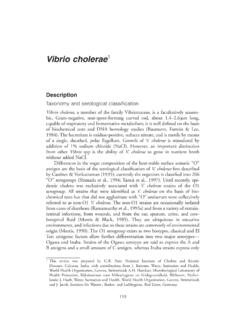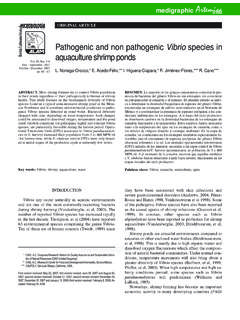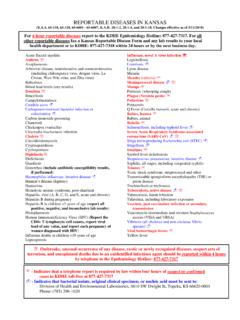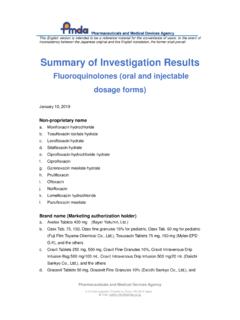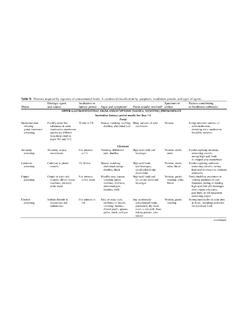Transcription of 08 Lecture 12 Infectious Diarrhea - Columbia University
1 Michael Yin Infectious Diarrhea A. Introduction Acute gastrointestinal illnesses rank second only to acute respiratory illnesses as the most common disease worldwide. In children less than 5 years old, attack rates range from 2-3. illnesses per child per year in developed countries to 10-18 illnesses per child per year in developing countries. In Asia, Africa, and Latin America, acute diarrheal illnesses are a leading cause of morbidity (1 billion cases per year), and mortality (4-6 million deaths per year, or 12,600 deaths per day) in children.
2 Most cases of acute Infectious gastroenteritis are caused by viruses (Rotavirus, Calicivirus, Adenovirus). Only 1-6% of stool cultures in patients with acute Diarrhea are positive for bacterial pathogens; however, higher rates of detection have been described in certain settings, such as foodborne outbreaks (17%) and in patients with severe or bloody Diarrhea (87%). This syllabus will focus on bacterial organisms, since viral and parasitic (Giardia, Entamoeba, Cryptosporidium, Isospora, Microspora, Cyclospora).
3 Causes of gastroenteritis are covered elsewhere. Clostridium difficile colitis will be covered in the Lecture and syllabus on Anaerobes. Diarrhea is an alteration in bowel movements characterized by an increase in the water content, volume, or frequency of stools. A decrease in consistency and an increase in frequency in bowel movements to > 3 stools per day have often been used as a definition for epidemiological investigations. Infectious Diarrhea is Diarrhea due to an Infectious etiology. Acute Diarrhea is an episode of Diarrhea of < 14 days in duration.
4 Persistent Diarrhea is an episode of Diarrhea > 14 days in duration, and chronic Diarrhea is Diarrhea that last for >30 days duration. B. Microbiology Many different bacteria can cause gastroenteritis. From studies of stool cultures performed in hospitals, the most commonly isolated bacterial pathogens are Campylobacter (42% of isolates), Salmonella (32%), Shigella (19%) and Escherichia coli O157:H7 (7%). Some organisms (Salmonella and Shigella species) are always associated with disease, while others (E.)
5 Coli) are members of the commensal flora and become pathogenic when they acquire virulence factor genes on plasmids, bacteriophages, or pathogenicity islands. vibrio species vibrio are Gram negative bacilli that grow naturally in estuarine and marine environments worldwide, and can survive in contaminated waters with increased salinity and temperature (up to 37 C). There are 12 species of vibrio that have been implicated in human infections, with the most prominent being vibrio cholerae , parahaemolyticus and vulnificus.
6 V. cholerae , the etiologic agent of cholera, is subclassified based upon somatic O antigens. V. cholerae O1 and O139 are responsible for causing classic cholera which MID 12. can occur in epidemics or worldwide pandemics. The seventh cholera pandemic which was caused by vibrio cholerae O1 biotype El Tor, began in Asia in 1961 and spread around the globe to the Americas in 1991, resulting in more than 1 million cases and 10,000 deaths in the Americas, alone. Cholera is spread by contaminated water and food and therefore, usually occurs in communities with poor sanitation.
7 Person-to-person spread is unusual because a high inoculum is required to produce disease. The clinical manifestation of cholera ranges from asymptomatic colonization to severe, rapidly fatal Diarrhea that begins 2-3 days after ingestion of the bacilli. The fluid loss from cholera can be profound and result in severe dehydration, metabolic acidosis (bicarbonate loss), hypokalemia (low potassium), and hypovolemic shock. The mortality rate is 60% in untreated patients but less than 1% in those who are promptly treated with replacement of lost fluids and electrolytes.
8 Noncholera vibrios such as vibrio parahaemolyticus can be transmitted through contaminated shellfish and cause a mild to severe secretory Diarrhea . Shigella species Shigella are Gram negative bacilli that have four recognized species: S. sonnei, S. flexneri, S. dysenteriae, S. boydii. S. sonnei enteritis occurs predominantly in industrialized countries while S. flexneri occurs in developing countries. S dysenteriae results in the most severe infections and S. boydii is infrequently isolated. Humans are the only known reservoirs for Shigella.
9 Shigellosis is transmitted by the fecal-oral route, primarily by people with contaminated hands and less commonly through contaminated water or food. Because only a small inoculum is necessary to establish disease (<200. bacilli), shigellosis spreads rapidly in institutions (daycare and custodial institutions) or communities where there are poor sanitary standards. Shigella invades and replicates in the cells lining the colonic mucosa resulting in symptoms ranging from a mild gastroenteritis to dysentery (abdominal pain, small and frequent bowel movements, stool with blood or mucous).
10 S. dysenteriae produces an enterotoxin, Shiga Toxin, which disrupts protein synthesis and produces endothelial damage. Campylobacter species Campylobacter are small, comma-shaped Gram negative bacilli with microaerophilic growth requirements. Thirteen species have been associated with human disease. C. jejuni, C. coli and C. upsaliensis are the most common causes of Campylobacter gastroenteritis. A variety of animals serve as reservoirs, and humans acquire C. jejuni and C. coli infection through consumption of contaminated poultry, milk and other foods.










